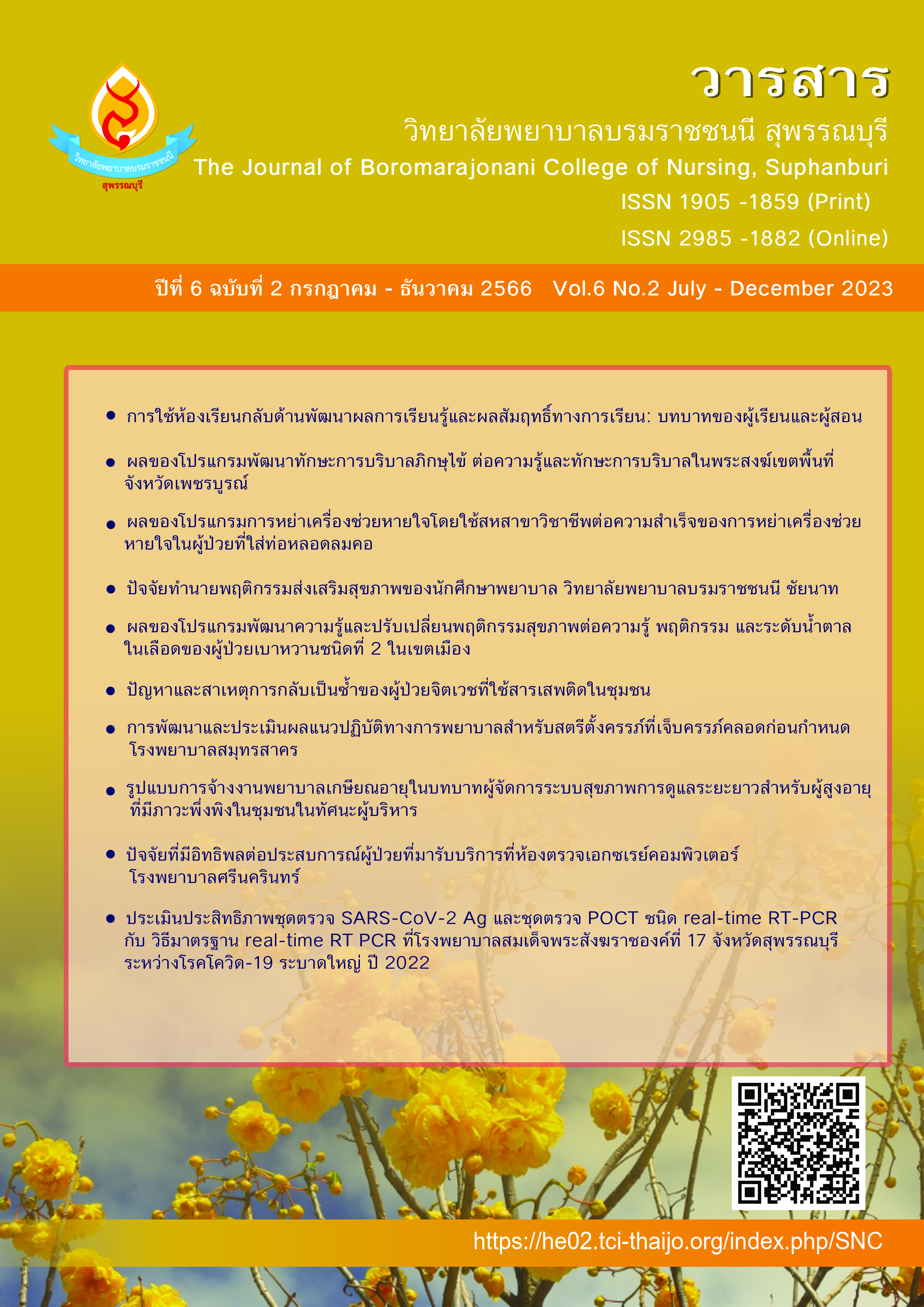ผลของโปรแกรมการหย่าเครื่องช่วยหายใจโดยใช้สหสาขาวิชาชีพต่อความสำเร็จของการหย่า เครื่องช่วยหายใจในผู้ป่วยที่ใส่ท่อหลอดลมคอ
คำสำคัญ:
การหย่าเครื่องช่วยหายใจ ผู้ป่วยที่ใส่ท่อหลอดลมคอ โปรแกรมการหย่าเครื่องช่วยหายใจบทคัดย่อ
การวิจัยกึ่งทดลองครั้งนี้มีวัตถุประสงค์เพื่อศึกษาผลของโปรแกรมการหย่าเครื่องช่วยหายใจโดยใช้สหสาขาวิชาชีพต่อความสำเร็จในการหย่าเครื่องช่วยหายใจในผู้ป่วยที่ใส่ท่อหลอดลมคอ ในหอผู้ป่วยหนักอายุรกรรม โรงพยาบาลพระจอมเกล้า จังหวัดเพชรบุรี กลุ่มตัวอย่าง คือ ผู้ป่วยที่มีภาวะหายใจล้มเหลวและใส่เครื่องช่วยหายใจ จำนวน 60 คน คัดเลือกกลุ่มตัวอย่างแบบเฉพาะจงตามคุณสมบัติที่กำหนด จำแนกเป็นกลุ่มทดลองและกลุ่มควบคุม กลุ่มละ 30 คน เครื่องมือวิจัย ประกอบด้วย โปรแกรมการหย่าเครื่องช่วยหายใจที่พัฒนาขึ้นและแบบบันทึกการหย่าเครื่องช่วยหายใจ ตรวจสอบความตรงตามเนื้อหาโดยผู้ทรงคุณวุฒิ จำนวน 5 คน วิเคราะห์หาค่าดัชนีความสอดคล้องได้เท่ากับ 0.80-1.00 ดำเนินการทดลองและเก็บรวบรวมข้อมูลตั้งแต่เดือนมีนาคม 2564 ถึงเดือนกุมภาพันธ์ 2565 วิเคราะห์ข้อมูลด้วยค่าเฉลี่ย มัธยฐาน และสถิติเปรียบเทียบด้วย Mann-Whitney U test
ผลการวิจัยพบว่า
- จำนวนวันที่ใส่ท่อหลอดลมคอและใช้เครื่องช่วยหายใจของกลุ่มที่ได้รับการดูแลตามโปรแกรมการหย่าเครื่องช่วยหายใจโดยใช้สหสาขาวิชาชีพน้อยกว่ากลุ่มที่ได้รับการดูแลตามแนวทางการหย่าเครื่องช่วยหายใจวิธีเดิมอย่างมีนัยสำคัญทางสถิติที่ระดับ .05
- ระยะเวลาในการหย่าเครื่องช่วยหายใจของกลุ่มที่ได้รับการดูแลตามโปรแกรมการหย่าเครื่องช่วยหายใจโดยใช้สหสาขาวิชาชีพน้อยกว่ากลุ่มที่ได้รับการดูแลตามแนวทางการหย่าเครื่องช่วยหายใจวิธีเดิมอย่างมีนัยสำคัญทางสถิติที่ระดับ .05
- จำนวนการกลับมาใส่ท่อหลอดลมคอซ้ำของกลุ่มที่ได้รับการดูแลตามโปรแกรมการหย่าเครื่องช่วยหายใจโดยใช้สหสาขาวิชาชีพไม่แตกต่างจากกลุ่มที่ได้รับการดูแลตามแนวทางการหย่าเครื่องช่วยหายใจวิธีเดิมอย่างมีนัยสำคัญทางสถิติที่ระดับ .05
ข้อค้นพบจากการวิจัยแสดงให้เห็นว่า การใช้โปรแกรมการหย่าเครื่องช่วยหายใจโดยใช้ทีมสหสาขาวิชาชีพ ช่วยเพิ่มความสำเร็จในการหย่าเครื่องช่วยหายใจของผู้ป่วยที่มีภาวะหายใจล้มเหลวได้
เอกสารอ้างอิง
ทนันชัย บุญบูรพงศ์. (2561). การบำบัดระบบหายใจในเวชปฏิบัติ (พิมพ์ครั้งที่ 8). กรุงเทพมหานคร: คณะแพทยศาสตร์โรงพยาบาลรามาธิบดี มหาวิทยาลัยมหิดล.
นิภาดา ธารีเพียร, ฐิตินันท์ วัฒนชัย และมนพร ชาติชำนิ. (2562). ประสิทธิผลของการใช้แนวปฏิบัติการดูแลผู้ป่วยที่ใช้เครื่องช่วยหายใจ. วารสารการพยาบาลและการดูแลสุขภาพ, 37(1), 70-79.
เพ็ญศรี ละออ, สุภาภรณ์ ด้วงแพง, วัลภา คุณทรงเกียรติ, และเขมารตี มาสิงบุญ. ประสิทธิผลของโปรแกรมการหย่าเครื่องช่วยหายใจสำหรับผู้ป่วยที่มีภาวะการหายใจล้มเหลวต่อความสำเร็จของการหย่าเครื่องช่วยหายใจและระยะเวลาการหย่าเครื่องช่วยหายใจ. วารสารคณะพยาบาลศาสตร์ มหาวิทยาลัยบูรพา, 15(2), 11-22.
หอผู้ป่วยหนักอายุรกรรม. (2563). สรุปผลงานประจำปี 2563. โรงพยาบาลพระจอมเกล้า จังหวัดเพชรบุรี.
อุดมลักษณ์ เตียสวัสดิ์, ดลวิวัฒน์ แสนโสม, อัจฉราวรรณ นาเมืองจันทร์, สุภาพรณ์ ตัณฑ์สุระ, ยุวดี บุญลอย และอภิสรา ส่งเสริม. (2560). การพัฒนาแนวปฏิบัติการพยาบาลผู้ป่วยใช้เครื่องช่วยหายใจในงานดูแลผู้ป่วยหนัก โรงพยาบาลขอนแก่น.วารสารการพยาบาลและการดูแลสุขภาพ, 35(1), 194-206.
Auld, S. C., Caridi-Scheible, M., Blum, J. M., Robichaux, C., Kraft, C., Jacob, J. T., ... & Murphy, D. J. (2020). ICU and ventilator mortality among critically ill adults with coronavirus disease 2019. Critical care medicine.
Blackwood, B., Burns, K. E., Cardwell, C. R., & O’Halloran, P. (2014). Protocolized versus non‐protocolized weaning for reducing the duration of mechanical ventilation in critically ill adult patients. Cochrane database of systematic reviews, (11).
Bruton, A. & McPherson, K. (2004). Impact of the introduction of a multidisciplinary weaning team on a general intensive care unit. International journal of therapy and rehabilitation, 11(9), 435-440.
Cohen, J. (2013). Statistical power analysis for the behavioral sciences. Academic press.
Faul, F., Erdfelder, E., Lang, A. G., & Buchner, A. (2007). G* Power 3: A flexible statistical power analysis program for the social, behavioral, and biomedical sciences. Behavior Research Methods, 39(2), 175-191.
Haas, C. F., & Loik, P. S. (2012). Ventilator discontinuation protocols. Respiratory care, 57(10), 1649-1662.
Hirzallah, F. M., Alkaissi, A., & do Céu Barbieri‐Figueiredo, M. (2019). A systematic review of nurse‐led weaning protocol for mechanically ventilated adult patients. Nursing in critical care, 24(2), 89-96.
Kapil, S., & Wilson, J. G. (2019). Mechanical ventilation in hypoxemic respiratory failure. Emergency Medicine Clinics, 37(3), 431-444.
Ladeira, M. T., Vital, F. M. R., Andriolo, R. B., Andriolo, B. N., Atallah, Á. N., & Peccin, M. S. (2014). Pressure support versus T‐tube for weaning from mechanical ventilation in adults. Cochrane Database of Systematic Reviews, (5).
Magalhães, P. A., Camillo, C. A., Langer, D., Andrade, L. B., Maria do Carmo, M. B., & Gosselink, R. (2018). Weaning failure and respiratory muscle function: what has been done and what can be improved?. Respiratory medicine, 134, 54-61.
Norisue, Y., Santanda, T., Nabeshima, T., Tomita, S., Saito, S., Kataoka, J., ... & Fujitani, S. (2021). Association of diaphragm movement during cough, as assessed by ultrasonography, with extubation outcome. Respiratory Care, 66(11), 1713-1719.
Papazian, L., Klompas, M., & Luyt, C. E. (2020). Ventilator-associated pneumonia in adults: a narrative review. Intensive care medicine, 46(5), 888-906.
Peñuelas, O., Keough, E., López-Rodríguez, L., Carriedo, D., Gonçalves, G., Barreiro, E., & Lorente, J. Á. (2019). Ventilator-induced diaphragm dysfunction: translational mechanisms lead to therapeutical alternatives in the critically ill. Intensive care medicine experimental, 7, 1-25.
Polit, D.F., & Beck, C.T. (2022). Essentials of nursing research: Appraising evidence for nursing practice (10th ed.). Philadelphia, PA: Wolters Kluwer.
Powers, S. K., Wiggs, M. P., Sollanek, K. J., & Smuder, A. J. (2013). Ventilator-induced diaphragm dysfunction: cause and effect. American journal of physiology. Regulatory, integrative and comparative physiology, 305, R464-R477.
Rose, L., Dainty, K. N., Jordan, J., & Blackwood, B. (2014). Weaning from mechanical ventilation: a scoping review of qualitative studies. American Journal of Critical Care, 23(5), e54-e70.
Rose, L. (2015). Strategies for weaning from mechanical ventilation: a state of the art review. Intensive and Critical Care Nursing, 31(4), 189-195.
Stonehouse, D. (2013). Support workers: key members of the multidisciplinary team. British Journal of Healthcare Assistants, 7(10), 512-514.
Tingsvik, C., Johansson, K., & Mårtensson, J. (2015). Weaning from mechanical ventilation: factors that influence intensive care nurses' decision‐making. Nursing in Critical Care, 20(1), 16-24.
van Diepen, S., Sligl, W. I., Washam, J. B., Gilchrist, I. C., Arora, R. C., & Katz, J. N. (2017). Prevention of critical care complications in the coronary intensive care unit: protocols, bundles, and insights from intensive care studies. Canadian Journal of Cardiology, 33(1), 101-109.
White, V., Currey, J., & Botti, M. (2011). Multidisciplinary team developed and implemented protocols to assist mechanical ventilation weaning: a systematic review of literature. Worldviews on Evidence‐Based Nursing, 8(1), 51-59.
ดาวน์โหลด
เผยแพร่แล้ว
ฉบับ
ประเภทบทความ
สัญญาอนุญาต
ลิขสิทธิ์ (c) 2023 วิทยาลัยพยาบาลบรมราชชนนี สุพรรณบุรี

อนุญาตภายใต้เงื่อนไข Creative Commons Attribution-NonCommercial-NoDerivatives 4.0 International License.
บทความที่ได้รับการตีพิมพ์เป็นลิขสิทธิ์ของวารสารวิทยาลัยพยาบาลบรมราชชนนี สุพรรณบุรี
ข้อความที่ปรากฏในบทความแต่ละเรื่องในวารสารวิชาการเล่มนี้เป็นความคิดเห็นส่วนตัวของผู้เขียนแต่ละท่านไม่เกี่ยวข้องกับวิทยาลัยพยาบาลบรมราชชนนี สุพรรณบุรี และคณาจารย์ท่านอื่นๆในวิทยาลัยฯ แต่อย่างใด ความรับผิดชอบองค์ประกอบทั้งหมดของบทความแต่ละเรื่องเป็นของผู้เขียนแต่ละท่าน หากมีความผิดพลาดใดๆ ผู้เขียนแต่ละท่านจะรับผิดชอบบทความของตนเองแต่ผู้เดียว



